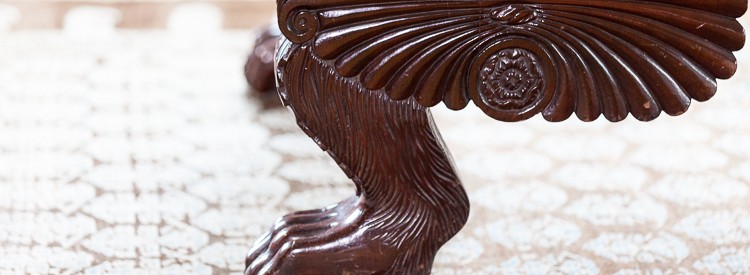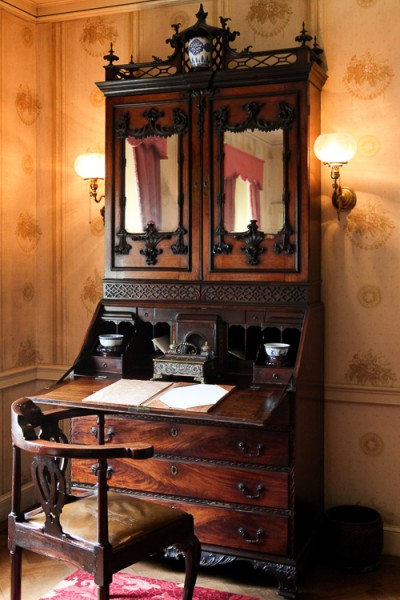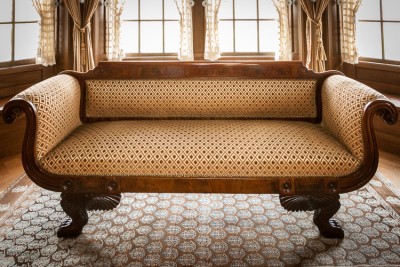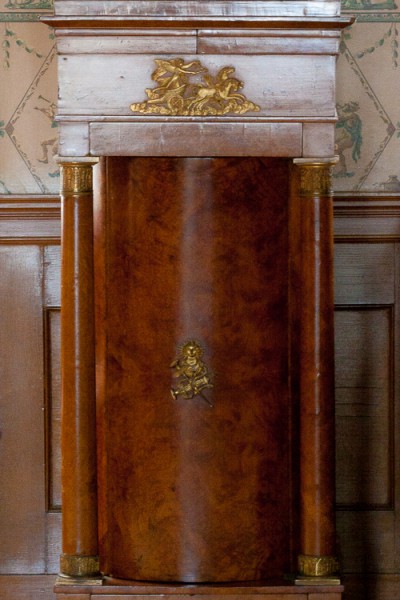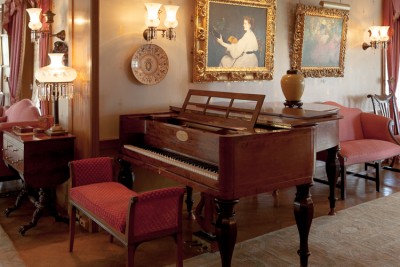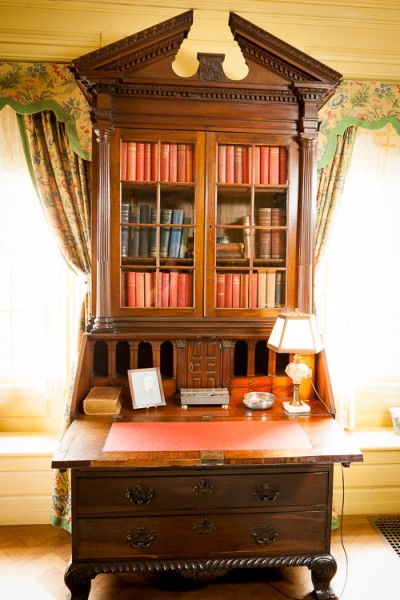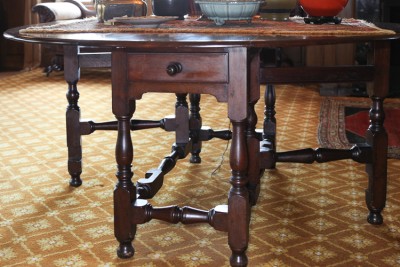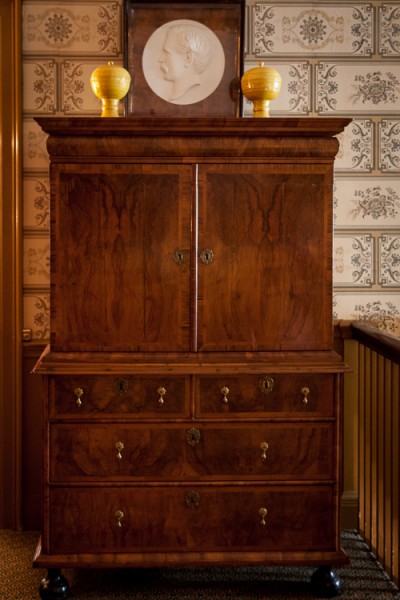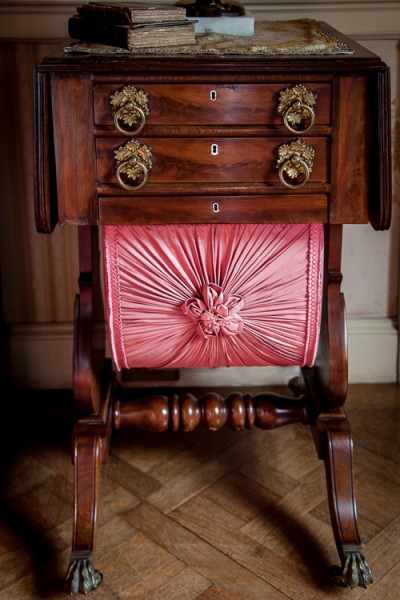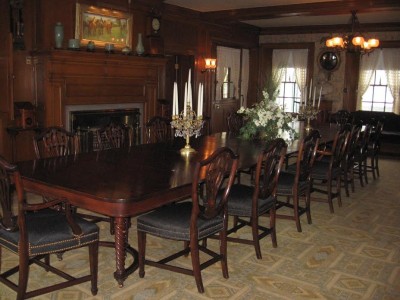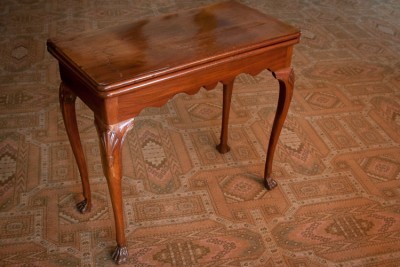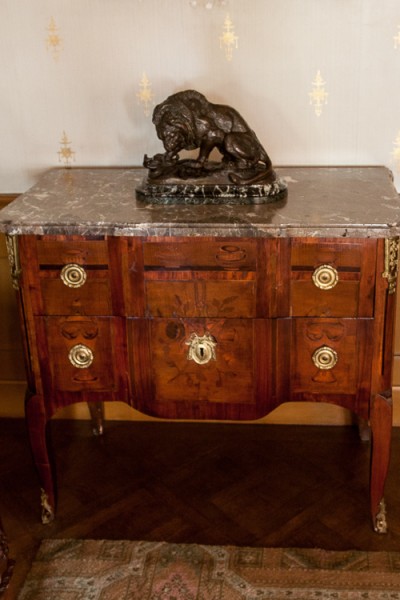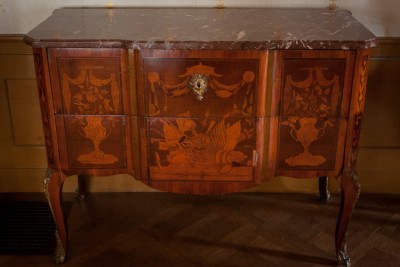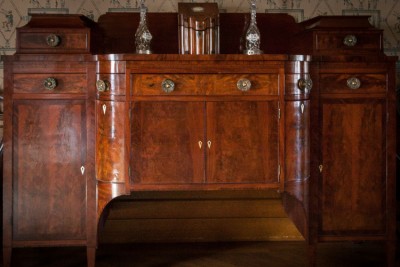Alfred and Ada Pope furnished Hill-Stead primarily with neo-classical pieces in the Chippendale, Federal and Empire styles. The furnishings are a mix of late 18th- to early 19th-century American-made pieces; 18th-century pieces from England, Ireland, France, Central Europe and Holland; and ca. 1900 reproductions. The understated elegance of Hill-Stead’s furnishings is a dramatic departure from the ornate Victorian and heavy Arts & Crafts aesthetic that had dominated the interiors of the middle-to-late 19th century. A few pieces from the late 17th century can also be seen in the collection and speak to Theodate Pope Riddle’s interest in older styles and the colonial aesthetic that she embraced.
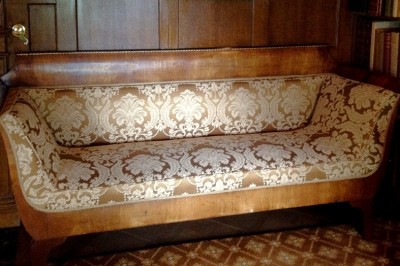 Biedermeier Sofa
Biedermeier Sofa
Cherry, ca 1820s, from Austria
The Biedermeier style was a simplified interpretation of the influential French Empire style popular in the early 1800s. The term Biedermeier originated from a work of social commentary which described the style as something that could be found in almost every home of the time. The word “bieder,” meaning unpretentious or plain, combined with Meier, a common German surname, to become Biedermeier.
Chippendale-style Secretary
Mahogany, late 19th-century
This secretary is a provincial imitation of Chippendale style. This piece has always been the object of study by furniture experts visiting Hill-Stead. It is believed to be a late 19th-century piece, and, possibly, a combination of old and “new” components. Intriguing, though not uncommon, are the seven secret drawers on the cabinet.
Empire-Style Sofa
Mahogany, 1820
The American Empire style of furniture was a less ornate variation on France’s Empire style of furniture, popular during Napoleon’s reign. It is characterized by simple, often massive, yet graceful curves and dark woods and veneers (mahogany was a common wood used). The sofa, in the Second Library, features winged, hairy paw feet, a feature of American Empire furniture. Much of the furniture in this room and in the adjacent First Library is Empire style, a more concentrated grouping of the style than in any other area of the home.
Shaving Stand
Burlwood Hungarian Ash with Ormolu Mounts, 1825-1850
This shaving stand exhibits design characteristics of French Empire or German Biedermier style even though it was made in Central Europe. The Popes used it as a display pedestal in the Dining Room for their bust of Marcus Aurelius rather than for its intended purpose. Beneath the hinged top is a mirror. Two leaves fold open to reveal the voids where a shaving bowl and assorted accoutrements would have been stored.
Steinway Piano
Model B in Mahogany with satinwood veneer and ebonized legs, 1901
Steinway & Sons sales records indicate that Hill-Stead’s piano is a Model B in mahogany, style 336, sold to Mrs. Alfred Pope on September 9, 1901. Mrs. Pope purchased this piano for the Drawing Room of her new home just months after moving in. The body is of satinwood veneer with inlaid stringing. The legs have been ebonized. An ivory medallion, inset above the keyboard, reads “Steinway & Sons, Makers, New York.”
Neoclassical Secretary
1750-1760
This secretary was made in Northern England’s Lancaster region. It is in the late Georgian or Neoclassical style, which corresponds to the accession to the throne of George III. Furniture of this period exhibits a great emphasis on form; straight lines replace the curves and flounces of Rococo furniture, and ornamentation and decoration are detailed and careful, with architectural elements. This secretary is fittingly located in the Morning Room that also showcases Theodate Pope Riddle’s collection of English architectural prints.
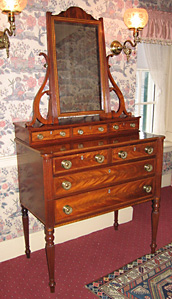 Dressing Table
Dressing Table
Made by Thomas Seymour, ca. 1808-1812
The Federal era, as exemplified by this ladies’ dressing table, is considered one of the most important periods of creativity and craftsmanship in American furniture-making history. This piece was made by Thomas Seymour, ca. 1808-1812. Thomas apprenticed with his father, English furniture maker John Seymour (who immigrated to the U.S. in 1784, first to Portland, ME, then later to Boston) and eventually opened the Boston Furniture Warehouse in 1804. The younger Seymour proved himself to be the more innovative designer and finer craftsman, and became renowned for high-style pieces of exceptional beauty and refinement. Seymour’s dressing tables with mirrors incorporated into the integral design were an innovation not heretofore seen in published designs of the period. While Seymour’s ambition was to produce London-quality furniture with sophisticated veneers, inlays and carving, he also produced simpler versions, such as the example here, to keep pace with a troubled economic climate in the years leading up to the War of 1812. A distinctive feature of Seymour’s work, even in lower-priced models, is the use of an exotic wood from Australia— “she oak” or “Botany Bay wood.” It is used here in cross-banding on the drawers.
Gate-Legged Table
Black walnut top, mahogany legs and oak rails, 1710
Made in New York, this gate-legged table, located in the Second Library, is the largest of many throughout the house. The top is made of black walnut, while the legs are of mahogany and the rails of oak. The grain of the top does not match the color or grain of the legs; the supposition by experts is that the top may be original while the legs, having a rougher finish and possibly from a lesser quality piece, were changed at some later date.
William and Mary Chest
Walnut and Scots pine, 1680
Standing 64 ¾ inches high and built in the William and Mary style, this chest features 17 drawers of varying shapes and sizes, and one secret compartment. All of the locks, teardrop-shaped escutcheon, and pendant pulls are original to the piece. Characteristic are its ball-shaped feet and minimally decorative brass pulls and hinges. The chest is representative of the transition from the squat, heavy, square furniture constructed during the first half of the 17th century to the lighter highboys and lowboys that came into popularity during the reign of King William and Queen Mary. This is one of the oldest pieces of furniture in the collection.
Sewing Tables
Boston, early 19th-century
The sewing table evolved from an 18th-century practice of placing sewing workboxes on stands. Early examples had a single drawer; over time, multiple drawers, special compartments, trays and wells were added. Throughout Hill-Stead several sewing tables were used primarily as side or occasional tables. The table shown here is from early 19th-century Boston. The top drawer has 14 divided compartments.
Mrs. Pope ordered this custom-designed table from A. H. Davenport Co., which had showrooms in Boston and New York. She desired an “antique-looking” piece of furniture to serve as the centerpiece of the Dining Room and to fit with the many federal-style and Neo-classical pieces throughout the house. The table has twelve leaves that can extend the length to just over nineteen feet. The table could comfortably seat at least sixteen guests.
Card Table
Ireland, ca. 1750
This card table, a furniture form the Popes favored, is one of several in the collection. Card tables were designed to be space savers, with the top folding in half so that the table could be stored against a wall when not in use. This table features a typical, Irish swollen ankle leg (the knob-like feature above the paw foot) and a felted surface with leather trim around the edge.
French Commodes
Both from 1760
Marble tops; variety of woods
These two French commodes flank the fireplace in the Drawing Room. Both pieces are from the transitional period between the Rococo style popular during the reign of Louis XV and the Neo-classical period of Louis XVI. The larger of the two, with the red marble top, exhibits more sophisticated marquetry than its counterpart. The red marble is from the 19th century and is labeled as being from California. The smaller commode with the gray-brown marble top is made from a variety of woods including sycamore, tulip, oak and amaranth. Both pieces have 19th-century ormolu mounts added to make them appear fancier and to update their style.
Sideboard
Empire with Greek fret motif banding, ca. 1820
A focal point in the Dining Room is the massive, New York-made Empire sideboard. The Empire style gained its greatest popularity in the U.S. after 1810 and is considered the second, more robust phase of the Neo-classical style. In American furniture, the Empire style was most notably exemplified by the work of New York cabinetmakers Duncan Phyfe (1768-1854) and Paris-trained Charles-Honoré Lannuier (1779-1819). Other major furniture centers renowned for regional interpretations of the American Empire style were Boston, Philadelphia, and Baltimore, cities the Popes frequented when purchasing furnishings for Hill-Stead. This sideboard features curved surfaces, prominent graining on the veneers and a Greek fret motif banding.
